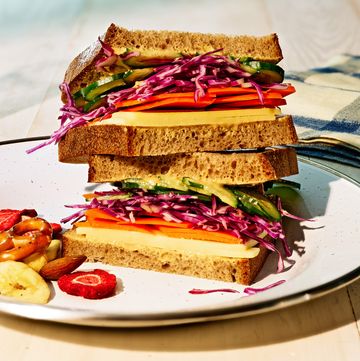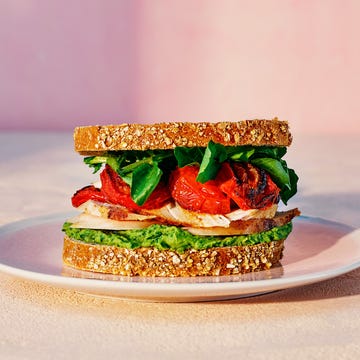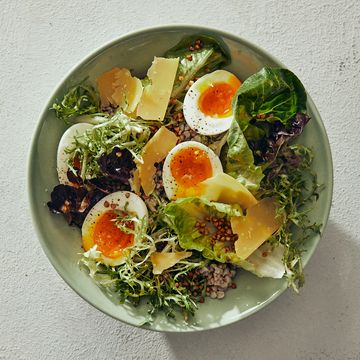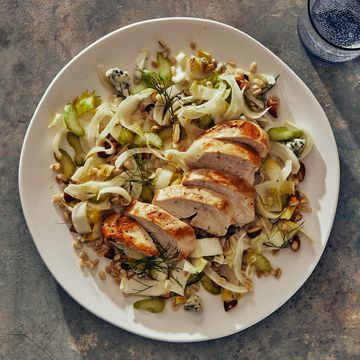When we think of oranges, Florida orange groves, kids' soccer games, and popsicles on a hot summer’s day all come to mind. So it might come as a surprise then that oranges are in season during the winter. While you can (like most other produce) get oranges in some form year-round, they’re generally in season December or January through April or May, says Regan Jones, R.D., and founder of Healthy Aperture. And while Florida dominates the orange growing market, they’re also cultivated in southern and central California, according to the University of California Davis.
When it comes to healthy foods, oranges are winners both in the taste and nutrition departments. “Citrus in general just seems to brighten up the flavor of almost anything you pair it with," Jones says. "Orange zest in baked goods, orange juice in sauces, dressings and marinades, orange segments as a snack or paired with savory grilled meats—all are options that one simple orange offers you,” says Jones.
Orange nutrition is second to none. The delicious fruit has calcium and fiber to make it a rewarding snack choice. It's also full of the antioxidant vitamin C, which can help boost your energy and fuel your weight-loss efforts—especially when paired with an iron-rich food like red meat or leafy greens. The vitamin C in oranges can also help you fight stress. So really, what's not to like? (Kick-start your new, healthy routine with Women's Health's 12-Week Total-Body Transformation!)
Here’s what else you should know about this citrus superstar before you stock up.
How many varieties of orange are there?
There are a wide variety of oranges out there, but here are a look at some common types you'll find at the grocery store:
Valencia Orange: Don't judge an orange by its peel. Jones says it's “not the prettiest on the outside,” with its yellow-tinted skin, but produces a sweet juice.
Navel Orange: This sweet, juicy orange is characterized by the "navel" (aka belly button) appearance at the top of the fruit. Fun fact: According to NPR, that navel is actually the result of a mutation. That little bellybutton is a tiny, second orange. It's naturally seedless, too.
Blood Orange: This variety has a deep ruby red and a tart to semi-sweet taste.
Cara Cara Orange: You can expect pink flesh with slightly reduced acidity.
Mandarins, tangerines, and clementines: These orange relatives are smaller than regular oranges and are generally sweeter, as well as easier to segment and peel.
Related: The 7 WORST Foods To Eat At Night
How to pick the best oranges at the grocery store
Contrary to its name, looking at color to guarantee freshness isn’t actually your best bet. Make sure they're firm, round, smooth and dense, avoiding anything that looks mushy, moldy or discolored.
How to store oranges
Jones notes that at room temperature, oranges only last about a week. Store them whole in the crisper in the fridge for freshness of up to three weeks. Wrap cut sections in plastic wrap to prevent them from drying out.
Related: 'I Shopped Once And Cooked 5 Times—Here's What I Ate'
How to prepare oranges
Jones says to use a sharp knife and cut across segments to produce circles, or slice them from top to bottom along the segment divider to produce wedges.
To eat it on its own, either peel it manually, or slice off the top and bottom and use a pairing knife to carefully cut away the peel. And don't throw out the peel once you've removed it from the orange—it can be used to make infused waters or thrown into mulled beverages for an extra citrus flavor.
If you're looking to segment an orange, Whole Foods produce butcher Emily Hankey recommends shaving off the excess pith (white part) of the orange first, then making slices on the remaining seam to cut out individual segments.
Here's the easiest way to peel an orange without making a mess:
How to cook with oranges
Besides eating oranges whole or juicing them, there are so many different things you can do with oranges. Here are some of Jones' favorite ideas:
- Zest is your best friend. To brighten up baked goods and enhance other flavors, peel thin slices of rind into muffin or bread mix or cookie dough. For a more subtle flavor, use a grater to zest the rind into tiny, flavor-packed bits and stir into what you're cooking with.
- Orange, cranberry, and pecan is a winning holiday dessert combination. Take a loaf of uncooked pizza dough, roll it into a rectangle, sprinkle and slather a combination of brown sugar, butter, pecans, orange zest, orange segments, and cranberries over the dough. Then, roll it up (starting at the long end), cut it into slices, and bake in a 400-degree oven for 20 to 30 minutes.
- For a Brie-utiful appetizer, combine orange segments, pistachios, and fig jam. Cut the top off of a Brie wheel, and place on microwave safe plate. Spread the orange mixture over it, and microwave at medium power until the cheese melts, around one or two minutes. You can also bake the Brie in the oven at 350 degrees until warm and oozing (but not totally melted). Serve with crackers.
- Oranges, meet meat. Jones says the fruit serves double duty as a rub for flank steak and a fruit-based salsa for faijtas. First, add some orange zest into a rub mixture of chili powder, salt, and black pepper. Coat the meat and refrigerate it overnight. While the meat is cooking the next day, segment that same orange (also to be refrigerated) over a bowl to catch the juices. Add in red onion, red bell pepper, toasted cumin seed (or ground cumin), salt, pepper, and cilantro. Serve with the meat either in the fajitas or over salad greens.
We also love pairing orange and fennel in dishes to make a truly delicious flavor combo. Try these recipes here.
Related: People Say This Popular Blender Is Exploding And Giving Them Serious Injuries
What is the nutrition of an orange?
According to the USDA, one medium-sized orange (sans peel) has 65 calories, one gram of protein, 0.3 grams of fat, 16 grams of carbs, 3 grams of fiber, and 13 grams of sugar. They've got a solid rep as being packed with vitamin C (although there are some foods that have even more) and have a decent calcium content (about six percent of your daily value). Orange peel is also packed with cancer-fighting d-limonene. However, eating too many oranges per day can trigger acid reflux since they're highly acidic, so limit your servings to no more than two per day if you're concerned.














